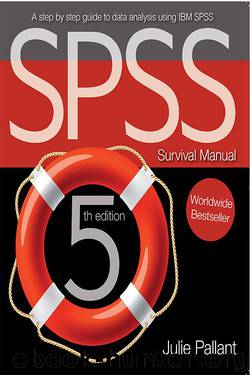Spss Survival Manual by Pallant Julie

Author:Pallant, Julie [Pallant, Julie]
Language: eng
Format: epub
Publisher: Open Univ Pr
Published: 2013-02-28T23:00:00+00:00
In Chapter 13, on multiple regression, we explored a technique to assess the impact of a set of predictors on a dependent variable (perceived stress). In that case, the dependent variable was measured as a continuous variable (with scores ranging from 10 to 50). There are many research situations, however, when the dependent variable of interest is categorical (e.g. win/lose; fail/pass; dead/alive). Unfortunately, multiple regression is not suitable when you have categorical dependent variables. For multiple regression your dependent variable (the thing that you are trying to explain or predict) needs to be a continuous variable, with scores reasonably normally distributed.
Logistic regression allows you to test models to predict categorical outcomes with two or more categories. Your predictor (independent) variables can be either categorical or continuous, or a mix of both in the one model. There is a family of logistic regression techniques available in IBM SPSS that will allow you to explore the predictive ability of sets or blocks of variables, and to specify the entry of variables. The purpose of this example is to demonstrate just the basics of logistic regression. I will therefore be using a Forced Entry Method, which is the default procedure available in IBM SPSS. In this approach, all predictor variables are tested in one block to assess their predictive ability while controlling for the effects of other predictors in the model. Other techniques—for example, the stepwise procedures (e.g. forward and backward)—allow you to specify a large group of potential predictors from which IBM SPSS can pick a subset that provides the best predictive power. These stepwise procedures have been criticised (in both logistic and multiple regression) because they can be heavily infuenced by random variation in the data, with variables being included or removed from the model on purely statistical grounds (see discussion in Tabachnick & Fidell 2013, p. 456).
In this chapter, I will demonstrate how to perform logistic regression with a dichotomous dependent variable (i.e. with only two categories or values). Here we will use the procedure labelled Binary Logistic. If your dependent variable has more than two categories, you will need to use the Multinomial Logistic set of procedures (not covered here, but available in IBM SPSS—see the Help menu). Logistic regression is a complex technique, and I would strongly recommend further reading if you intend to use it (see Hosmer & Lemeshow 2000; Peat 2001; Tabachnick & Fidell 2013; Wright 1995).
ASSUMPTIONS
Sample size
As with most statistical techniques, you need to consider the size and nature of your sample if you intend to use logistic regression. One of the issues concerns the number of cases you have in your sample and the number of predictors (independent variables) you wish to include in your model. If you have a small sample with a large number of predictors, you may have problems with the analysis (including the problem of the solution failing to converge). This is particularly a problem when you have categorical predictors with limited cases in each category. Always run Descriptive Statistics
Download
This site does not store any files on its server. We only index and link to content provided by other sites. Please contact the content providers to delete copyright contents if any and email us, we'll remove relevant links or contents immediately.
| Biomathematics | Differential Equations |
| Game Theory | Graph Theory |
| Linear Programming | Probability & Statistics |
| Statistics | Stochastic Modeling |
| Vector Analysis |
Modelling of Convective Heat and Mass Transfer in Rotating Flows by Igor V. Shevchuk(6406)
Weapons of Math Destruction by Cathy O'Neil(6215)
Factfulness: Ten Reasons We're Wrong About the World – and Why Things Are Better Than You Think by Hans Rosling(4713)
A Mind For Numbers: How to Excel at Math and Science (Even If You Flunked Algebra) by Barbara Oakley(3256)
Descartes' Error by Antonio Damasio(3248)
Factfulness_Ten Reasons We're Wrong About the World_and Why Things Are Better Than You Think by Hans Rosling(3216)
TCP IP by Todd Lammle(3155)
Fooled by Randomness: The Hidden Role of Chance in Life and in the Markets by Nassim Nicholas Taleb(3080)
Applied Predictive Modeling by Max Kuhn & Kjell Johnson(3041)
The Tyranny of Metrics by Jerry Z. Muller(3028)
The Book of Numbers by Peter Bentley(2931)
The Great Unknown by Marcus du Sautoy(2662)
Once Upon an Algorithm by Martin Erwig(2622)
Easy Algebra Step-by-Step by Sandra Luna McCune(2604)
Lady Luck by Kristen Ashley(2554)
Police Exams Prep 2018-2019 by Kaplan Test Prep(2516)
Practical Guide To Principal Component Methods in R (Multivariate Analysis Book 2) by Alboukadel Kassambara(2513)
All Things Reconsidered by Bill Thompson III(2371)
Linear Time-Invariant Systems, Behaviors and Modules by Ulrich Oberst & Martin Scheicher & Ingrid Scheicher(2346)
